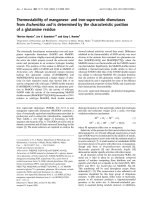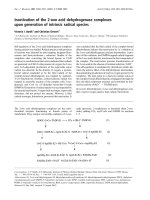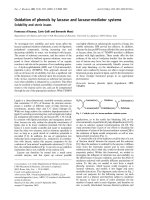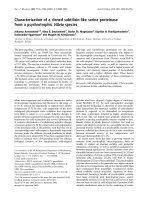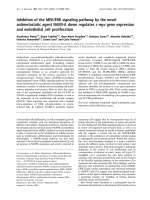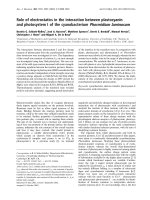Báo cáo y học: "Duration of bed occupancy as calculated at a random chosen day in an acute care ward. Implications for the use of scarce resources in psychiatric care" pps
Bạn đang xem bản rút gọn của tài liệu. Xem và tải ngay bản đầy đủ của tài liệu tại đây (221.75 KB, 6 trang )
BioMed Central
Page 1 of 6
(page number not for citation purposes)
Annals of General Psychiatry
Open Access
Primary research
Duration of bed occupancy as calculated at a random chosen day in
an acute care ward. Implications for the use of scarce resources in
psychiatric care
John E Berg*
1
and Asbjørn Restan
2
Address:
1
Lovisenberg Diaconal Hospital 0440 Oslo, Norway and
2
Akershus University Hospital Clinic of Psychiatry 1484 Lørenskog, Norway
Email: John E Berg* - ; Asbjørn Restan -
* Corresponding author
Psychiatryresident treatmentcost-effectivenesstreatment logistics
Abstract
Background: Psychiatric acute wards are obliged to admit patients without delay according to the
Act on Compulsive Psychiatric Care. Residential long term treatment facilities and rehabilitation
facilities may use a waiting list. Patients, who may not be discharged from the acute ward or should
not wait there, then occupy acute ward beds.
Materials and methods: Bed occupancy in one acute ward at a random day in 2002 was
registered (n = 23). Successively, the length of stay of all patients was registered, together with
information on waiting time after a decision was made on further treatment needs. Eleven patients
waited for further resident treatment. The running cost of stay was calculated for the acute ward
and in the different resident follow-up facilities. Twenty-three patients consumed a total of 776
resident days. 425 (54.8%) of these were waiting days. Patients waited up to 86 days.
Results: Total cost of treatment was 0.69 million Euro (0.90 mill. $), waiting costs were 54.8% of
this, 0.38 million Euro (0.50 million $). The difference between acute care costs and the costs in
the relevant secondary resident facility was defined as the imputed loss. Net loss by waiting was
0.20 million Euro (0.26 million $) or 28.8% of total cost.
Discussion: This point estimate study indicates that treating patients too sick to be released to
anything less than some other intramural facility locks a sizable amount of the resources of a
psychiatric acute ward. The method used minimized the chance of financially biased treatment
decisions. Costs of frustration to staff and family members, and delayed effect of treatment was set
to zero. Direct extrapolation to costs per year is not warranted, but it is suggested that our findings
would be comparable to other acute wards as well. The study shows how participant observation
and cost effectiveness analysis may be combined.
Background
Treatment of acute psychiatric illness in resident settings is
expensive, albeit less so than in intensive medical care
units [1-3]. The costs are to a great extent indispensable,
Published: 27 May 2005
Annals of General Psychiatry 2005, 4:11 doi:10.1186/1744-859X-4-11
Received: 04 February 2004
Accepted: 27 May 2005
This article is available from: />© 2005 Berg and Restan; licensee BioMed Central Ltd.
This is an Open Access article distributed under the terms of the Creative Commons Attribution License ( />),
which permits unrestricted use, distribution, and reproduction in any medium, provided the original work is properly cited.
Annals of General Psychiatry 2005, 4:11 />Page 2 of 6
(page number not for citation purposes)
but not of the same magnitude in all elements of the treat-
ment chain. Allocation of patients in a treatment and cost-
efficient way along this chain is a logistic challenge.
Regression-based cost functions have been used to illus-
trate patient and system related cost elements[4]. The pos-
sibility of violence in acute psychosis is an important
contributor to the costs[5]. Psychiatric acute wards in Nor-
way are obliged by law, the Norwegian Act on Compulsive
Psychiatric Care (ACPC), to accept persons who, after an
examination by an external doctor are found to be in dan-
ger of severely damaging own life or other people's lives.
Reasons for referrals are acute psychosis, mania, or severe
suicidal conditions. A person may be referred voluntarily
to a mental hospital, or for compulsory observation of up
to 10 days or for compulsory treatment for a prolonged
period of time. Not later than 24 hours after admission
the consultant psychiatrist on duty has to make a legally
binding decision on admission status. The patient or his
relatives may appeal this decision to a legal body outside
the hospital.
The acute wards are often the first step in a chain of facil-
ities that the patient may need in order to regain his func-
tional ability. Such secondary facilities, sub-acute/
intermediate wards, long term treatment, half-way houses
or nursing care homes are, however, not obliged to accept
patients at demand, but rather as empty places/beds
become available. The result may be crowded acute wards.
Either because too many patients are referred to the wards
per time unit or because patients do not get another place
to stay, if they are too sick to be transferred to community
services of ambulatory type.
Shortened duration of resident stays might be cost-effec-
tive treatment, although the clinical outcome may be var-
iable. High rates of relapse may be counterproductive. In
a Norwegian study relapses were shown not to be an indi-
cator of efficiency, but rather of logistic planning of men-
tal health services[6].
Waiting time whilst in resident acute care has not, to our
knowledge, been studied from a clinical and economic
standpoint using cross-sectional data.
The decision on length of stay was taken on daily meet-
ings of the treatment staff, where all the doctors, psychol-
ogist and social workers were present. The group of senior
psychiatrists decided where the patient should be referred
after acute care treatment. If no resident place was availa-
ble at the desired time, the patient had to wait in the acute
ward for such a slot.
The aim of the study was thus to present a novel way of
calculating the partial cost efficiency of waiting time in
one of four acute wards in the city of Oslo (ca 500.000
inhabitants).
Methods
All resident patients (N = 23) on a randomly chosen day
in March 2002 were included. Day of entry, which was dif-
ferent from the chosen day, legal admission status, sex,
age and number of previous resident stays were noted, see
table 1 and figure 1.
Only one of the authors, JEB, a psychiatrist in training at
the time of the study, was aware of the registration of time
from the senior psychiatrists decision to the actual day of
referral to the next step in the treatment chain, called deci-
sion days in figure 1. Waiting days were defined as the
number of days from this decision date to the factual
transfer. Patients were initially evaluated for some days
before such a decision would be made. One patient was
still waiting at study end. Waiting time for this patient was
truncated at the end of the study period.
Cost estimation
Direct costs of treatment were calculated as the daily inpa-
tient expenditures multiplied by number of days. The
same costing procedure was used for cost of stay per day
in the different secondary facilities. Cost of waiting in the
acute ward was then calculated as the difference between
cost of residency in the acute ward and the chosen second-
ary facility. This cost was withdrawn from the cost of the
acute ward stay for each patient. The costs used in the cal-
culations were taken from the hospital and secondary
facility balances of 2001.
Results
Twenty-three patients were in the acute wards at the cho-
sen day. Twelve were men (52.2%) and 11 (47.8%)
women. Mean age was 35.7 (SD = 9.3) with a range from
22 to 56, table 1. Four patients were referred voluntarily to
the acute ward, 8 were under compulsory observation,
and 11 under compulsion for a prolonged period.
Eleven patients (47.8%) waited for secondary resident
treatment. All patients waiting for further intramural treat-
ment suffered from a psychotic illness, whereas 8 of 12
not waiting had a psychotic illness.
Duration of stay was composed of the days preceding the
chosen day and the number of days of further treatment
in the acute ward. Twenty-three patients had a total of 776
days, of which 425 (54.8 %) were waiting days as defined
above. Waiting time for single patients varied from one
day to 86 days. There were altogether 7925 resident days
in the wards during the year 2001.
Annals of General Psychiatry 2005, 4:11 />Page 3 of 6
(page number not for citation purposes)
Net running costs for the acute wards that year were
7,001,960 Euro (9,156,410 $). Spurious incomes of
394,853 Euro (516,346 $) and the acute ward's share of
the food, cleaning, and computer services costs of the
whole general hospital were not included.
Net running costs of the largest secondary facility were
8,095,343 Euro (10,586,217 $). The number of resident
days were, respectively, 7919 and 14187 during 2001.
Mean cost per day of treatment was 884 Euro (1156 $)
and 570 Euro (746 $), respectively for the acute wards and
the largest secondary facility. The cheapest secondary
facility had a cost per patient day of 168 Euro (219 $).
Table 2 gives the percentage of patients waiting at ran-
domly chosen days from each of ten other months of
2002. From 9.5% to 39.1% waited on the chosen days.
Mean age varied from 34.9% (SD = 8,0) to 39.4% (SD =
10,1) on the chosen days. For those waiting mean age was
34.0 (SD = 9.0) and for those not waiting for further intra-
mural treatment 38.0 (SD = 11.2).
Net running cost was 686,132 Euro (897,250 $) and the
amount allocated to waiting 375,781 Euro (491,406 $),
i.e. 54.8 %. The net loss accrued in the acute wards was
197,693 Euro (258,522 $), and constitutes 28.8 % of net
running cost, i.e. the difference between waiting cost at
the acute wards because of delayed further referrals and
the net running cost at the secondary facilities.
Discussion
The impression of many clinicians that patients are wait-
ing unnecessarily in the acute wards is confirmed by the
present study. The net loss to the chain of treatment facil-
ities, regardless of where the loss is incurred, was 28.8% of
total net running costs, as calculated for the 425 waiting
days in resident treatment. A financial system exists that
does not contribute to make these costs explicit. Neither
the acute wards nor the secondary resident facilities were
made economically responsible for the imputed loss. Cost
containment would be attained more easily if the eco-
nomic responsibility covered the complete chain of facili-
ties. That would also give more efficient logistics of
patients through the treatment chain.
Patients had to wait in the acute ward because referral to
ambulatory treatment or treatment at home was deemed
clinically irresponsible by the senior psychiatrists.
As shown in table 2, the choice of one day in March rep-
resented a higher percentage of waiting patients than post
hoc observed for the rest of the year. Length of waiting is,
however, not causally related to number of waiting
patients, but to factors inherent in the logistics of the psy-
chiatric treatment sector.
Table 1: Socioeconomic data and level of compulsion according to ACPC* by entry for 23 patients who all were inpatients on a
random chosen day in 2003 in the acute wards of a psychiatric hospital, (Standard deviation).
Waiting for further treatment Not waiting
(N = 11) (N = 12)
Men 75
Women 4 7
Mean number of earlier referrals 3.6 (3.2) 5.7 (6.2)
Mean age 34.4 (10.4) 36.8 (8.6)
Psychotic illness 11 (47.8%) 8 (34.8%)
§according to Law:
§2-1 (voluntarily) 1 3
§3-6 (compulsory observation) 5 3
§3-3 (compulsion) 5 6
§as decided by senior psychiatrist within 24 hours after admission:
§2-1 1 3
§3-6 3 3
§3-3 7 6
*) ACPC = The Norwegian Act on Compulsory Psychiatric Care of 1999.
Annals of General Psychiatry 2005, 4:11 />Page 4 of 6
(page number not for citation purposes)
We have not tried to aggregate our results to an effect for
a longer period of time, as this would demand more data
on both costs and incomes to the whole treatment chain
[7,8]. The present study was not set up to comply with
such a comprehensive cost utility or cost effectiveness
analysis.
Treatment planning for schizophrenia patients after hos-
pitalisation and into more permanent care outside the
hospital has been difficult to standardise, but studies
show that this would be of importance [9,10]. Early inter-
vention in recently diagnosed schizophrenia has been
advocated as a method to reduce future loss of functional
abilities[11]. Early intervention is aimed at reducing dura-
tion of untreated psychosis, DUP time. Successful reduc-
tion of DUP time is also suggested to reduce costs of long-
term treatment. Patients with substantial psychosocial
problems are also frequent users of resident treat-
Number of resident days for 11 out of 23 patients in an acute ward before a decision was made for further intramural treat-ment in a less costly facility, and number of waiting days after the decision dayFigure 1
Number of resident days for 11 out of 23 patients in an acute ward before a decision was made for further intramural treat-
ment in a less costly facility, and number of waiting days after the decision day. Twelve patients did not wait for other intramu-
ral treatment, and did not accumulate waiting days.
Decision days Waiting days
14 0 65 86days
Annals of General Psychiatry 2005, 4:11 />Page 5 of 6
(page number not for citation purposes)
ment[12]. The difference between ambulatory and resi-
dent psychiatric care was studied by Creed etal in a
randomised controlled trial of 179 patients deemed to
profit from either[1]. The authors found, as expected, that
day treatment was cheaper than inpatient treatment for
those patients who could be in day treatment. Inpatients
improved significantly faster, but at 12 months the bur-
den on families, also the economic burden, was equal in
the two groups. Deinstitutionalisation has been studied in
a cost effectiveness perspective[13]. Cost of treatment was
lower in long-term patients discharged from hospital
compared to those staying. Released patients turned out
to be healthier along several dimensions of positive
health.
Patients in need of continued care are often best helped by
treatment and rehabilitation efforts close to where they
live. Such care can be sufficient and appropriate after acute
care, but a priori it is not necessarily cost effective. If this
really is the case, it would be even more important to use
acute care resources in an efficient way, i.e. delivering the
services needed at the right time in the right facility.
Waiting time is not per se a waist of money [14]. Zero
waiting time requires excess capacity, probably higher
than necessary from a public point of view. The American
health financial system is organised with a tilt towards
shorter waiting times, and thus towards higher expendi-
ture per capita. Waiting time should be the result of clini-
cal judgments, not bad logistics.
Direct costs, as daily inpatient expenditures multiplied by
number of days, were used in a study of waiting time
before relapse in schizophrenia in USA. Indirect costs of
treatment were not estimated[15]. A similar approach,
disregarding other ancillary costs, was used in the present
study. Cost of illness analysis estimates running and
maintenance costs as direct costs, and cost of mortality
and morbidity as indirect costs[2,16]. Dorothy Rice found
that the direct costs of schizophrenia and affective disor-
ders were twice the indirect costs. The share of the costs of
these two illnesses was higher than the prevalence would
suggest. However, cost of illness analysis tends to give
huge cost estimates, disregarding any imputed gain for
others.
One group of patients was not considered as waiting in
the present study. Several of our patients are referred to
the acute ward partly because they also are homeless, and
they often get their stay prolonged for social reasons.
Homelessness is partly a social welfare problem, but
might also be a corollary to the incumbent loosing his
home because of psychotic acts (fires, non-payment of
rent, destructive and disturbing behaviour).
The patients waiting in the acute wards used the services
of the department to the same extent as the other patients,
they were not "idly waiting". Some established a close
therapeutic relationship to therapists in the acute ward,
who later could not follow up the patient due to other
tasks. This may be detrimental to some patients, and
could have been avoided if referrals to secondary institu-
tions were smoother. The burden on the families would
also be increased by the uncertainty[17]. These factors are
not part of the calculations of the study, but would if
entered have increased the imputed loss. In a study of re-
entries, half the patients had previously been resident
patients[6]. Fewer re-entries were observed in patients
with long and planned stays, sufficiently organised end of
resident stay and follow-up visits. The amount of follow-
up by community centres did not improve outcome. Lack
of beds in the acute wards due to waiting also affects the
health of those seeking treatment, as they would have to
wait longer and get their mental status deteriorated.
Table 2: Patients referred to the acute wards during the first ten months of 2002 according to waiting status (%) and level of
compulsion according to the ACPC.
Month Waiting (%) Level of compulsion (%)
Yes No §2-1 Voluntary treatment §3-6 Compulsory observation §3-3 Compulsory treatment
1 31.0 69.0 44.8 6.9 48.3
2 39.1 60.9 39.1 13.0 47.8
3 33.3 66.7 25.0 16.7 58,3
4 16.7 83.3 50.0 12.5 37.5
5 25.0 75.0 53.1 21.9 25.0
6 29.2 70.8 37.5 12.5 50.0
7 28.6 71.4 46.4 10.7 42.9
8 9.5 90.5 52.4 19.0 286
9 34.8 65.2 52.2 8.7 39.1
10 27.6 72.4 31.0 10.3 58.6
Annals of General Psychiatry 2005, 4:11 />Page 6 of 6
(page number not for citation purposes)
The impact of waiting on staff performance and therapeu-
tic efforts has not been studied here, but would perhaps
also be of importance for sick leave and burnout.
It is probably a questionable option to shorten resident
stays in the acute wards without augmenting the quantity
and/or quality of services outside the ward, but it would
partly solve the lack of beds, before re-entries increases.
Cost of new antipsychotic medication has been used as an
argument for cost containment. But at Norwegian prices
for medication, even the most expensive atypical antipsy-
chotics in relevant doses for a patient year would not cost
more than 7–8 days of resident treatment [18,19].
Waiting for treatment may be rational. Absolutely no
waiting for entry to a facility in the treatment chain would
demand a capacity which would not be used cost effi-
ciently, the case observed for instance in the airline busi-
ness. If waiting is necessary, we should avoid waiting at
the most expensive slots in the chain, i.e. in acute wards
for psychiatric treatment[14]. The financial system of pub-
lic health care treatment chains makes it difficult to dis-
cover where the financial loss accrues, as the acute wards
in this case do not take regress on the extra expenses at the
following secondary facility not offering a treatment
option at the desired time point.
The referring doctors outside the acute ward find it
increasingly difficult to send patients to acute care, and
the number of compulsory referrals is high, in this study
19 out of 23 patients. This would probably represent an
economic burden on the families of severely ill psychiatric
patients in the case of unduly delayed referrals[17]. The
costs demonstrated in the present study should therefore
be viewed as a minimum estimate. Modern psychiatric
treatment should thus be given the possibility to use the
given economic and clinical resources in a cost effective
way. This would also include care given by municipalities
and private contributors.
Conclusion
A substantial part of the costs of running an acute psychi-
atric ward, 29% of running costs in this study, were allo-
cated to waiting. Better logistics in the treatment chain
could change this, and several economic incentives along
the chain could be used. A treatment chain were only one
link is obliged to accept patients without delay, would
probably not be the ideal solution. This study indicates
that participant observation and cost effectiveness analy-
sis may be combined.
Conflict of interest
Both authors were salaried workers in the facility at the
time of the study. No financial or other conflicts of inter-
est were present.
References
1. Creed F, Mbaya P, Lancashire S, Tomenson B, Williams B, Holme S:
Cost effectiveness of day and inpatient psychiatric treat-
ment: results of a randomised controlled trial. BMJ 1997,
314:1381-5.
2. Rice DP: The economic impact of schizophrenia. J Clin Psychiatry
1999, 60(suppl 1):4-6.
3. Thieda P, Beard S, Richter A, Kane J: An economic review of com-
pliance with medication therapy in the treatment of
schizphrenia. Psychiatric Services 2003, 54:508-16.
4. Kilian R, Matschinger H, Becker T, Angermeyer M: A longitudinal
analysis of the impact of social and clinical characteristics on
the costs of schizophrenia treatment. Acta Psychiatr Scand 2003,
107:351-60.
5. Shepherd J: Violence in health care. Understanding, preventing and surviv-
ing violence: A practical guide for health professionals 1st edition. Oxford:
Oxford University Press; 2001.
6. Lien L: Are readmission rates influenced by how psychiatric
services are organized? Nord J Psychiatry 2002, 56:23-8.
7. Drummond MF: Principles of economic appraisal in health care 1st edi-
tion. Oxford Medical Publications; 1989.
8. Andrews G, Hall W, Goldstein G, Lapsley H, Bartels R, Silove D: The
economic costs of schizophrenia. Implications for public
policy. Archives of General Psychiatry 1985, 42:537-43.
9. Jones A: Hospital care pathways for patients with
schizofrenia. J Clin Nurs 2001, 10:58-69.
10. VandenBroek M, McNestry F, Dobby A: Utilization management
in inpatient psychiatry. Hosp Quart 2001, 5:60-4.
11. Larsen TK, McGlashan TH, Johannessen JO, Friis S, Guldberg C,
Haahr U, et al.: Shortened duration of untreated first episode
of psychosis: changes in patient characteristics at treatment.
Am J Psychiatry 2001, 158:1917-19.
12. Keefler J, Duder S, Lechman C: Predicting length of stay in an
acute care hospital: the role of psychosocial problems. Soc
Work Health Care 2001, 33:1-16.
13. Reinharz D, Lesage AD, Contandriopoulos AP II: Cost-effective-
ness analysis of psychiatric deinstitutionalization. Canadian
Journal of Psychiatry 2000, 45:533-8.
14. Bramness G, Christiansen V: Køer som rasjoneringsmetode. en teori om
ressurskrevende allokeringsmekanismer og noen momenter i teorien om
optimale offentlige investeringer (Waiting time as a rationing mechanism, a
theory of allocation of resources, and some points on the theory of optimal
public investments) Oslo: Universitetsforlaget; 1976.
15. Weiden PJ, Olfson M: Cost of relapse in schizophrenia. Schizo-
phrenia Bulletin 1995, 21:419-29.
16. Rice D, Kelman S, Miller L: The economic burden of mental
illness. Hosp Community Psychiatry 1992, 43:1227-32.
17. Fadden G, Bebbington P, Kuipers : Caring and its burdens. A
study of the spouses of Depressed Patients. Br J Psychiatry 1987,
151:660-7.
18. Jönsson B, Bebbington PE: What price depression? The cost of
depression and the cost-effectiveness of pharmacological
treatment. Br J Psychiatry 1994, 164:665-73.
19. Lecompte D, Cookson RF: The economic value of atypical
antipsychotics: a comparison of risperidone and olanzapine
revisited. Int J Psychiatry in Clinical Practice 1999, 3:3-9.

